Thermal Analysis of Vacuum Resistance Furnace
Abstract
1. Introduction
2. Existing Furnace Description
2.1. Geometry and Experimental Setup
2.1.1. Analytical Analysis
- Inside working zone: 1000 °C (T1)
- Outside insulation package: 718 °C (T2)
2.1.2. Heat Loss Calculations
- K is thermal conductivity, W/(m. K)
- Q is heat flow (in the present study, it is the heat flow from inside the working zone towards the outer shell), Watts
- T1 is temperature at r1
- T2 is temperature at r2
- L is the length of the cylinder
- Rt is the total thermal contact resistance of the insulation system
2.1.3. Modeling Analysis
3. Modified Furnace Description
3.1. Numerical Study
3.2. Experimental Study
- Inside hot zone: 1000 °C
- Outside insulation: 468 °C
4. Validation of Experimental Results
Verification of Experimental and Numerical Data
5. Conclusions
Supplementary Materials
Author Contributions
Funding
Acknowledgments
Conflicts of Interest
Appendix A
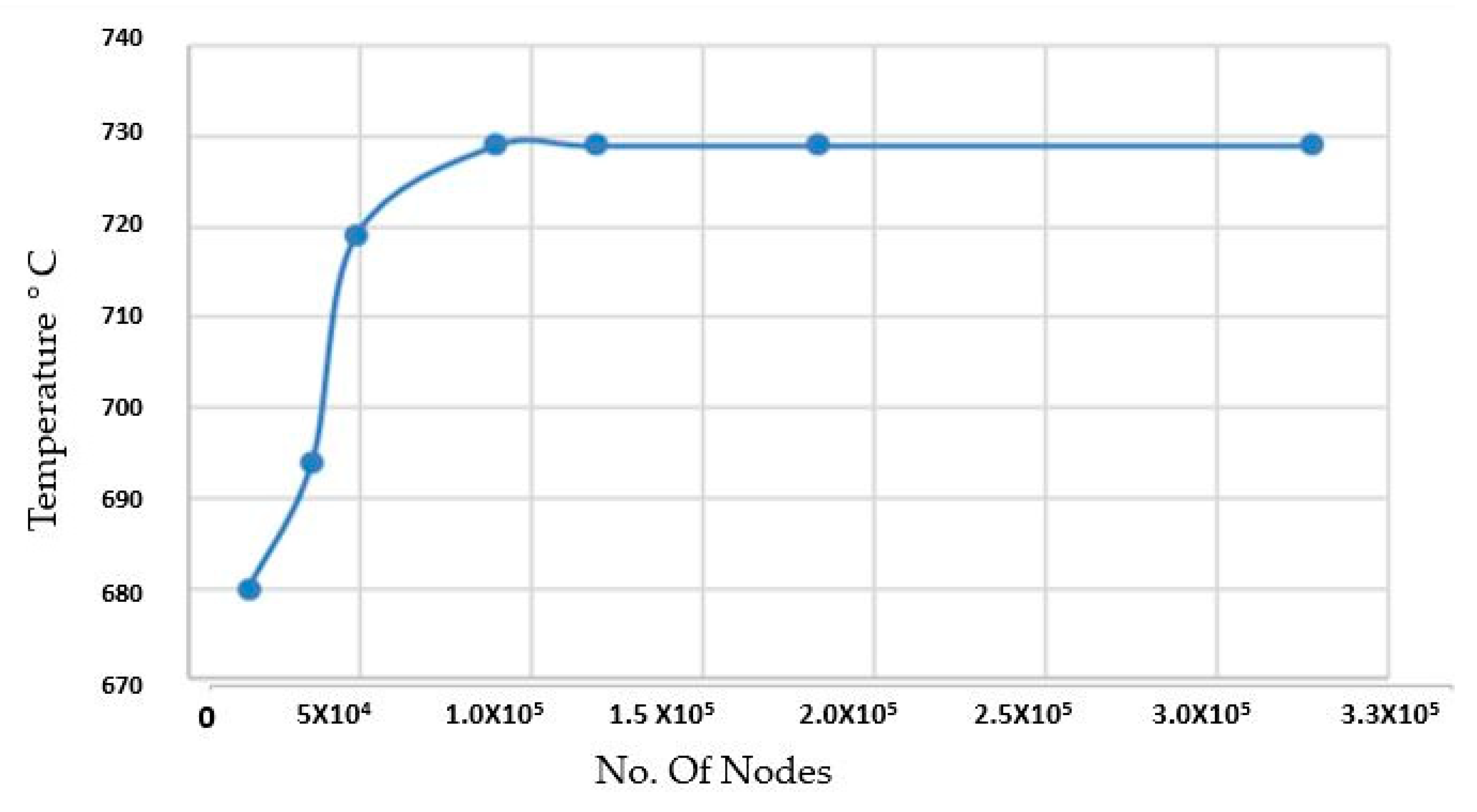
Appendix B
| Insulation Thickness | Annual Capital Cost of Operation |
|---|---|
| (mm) | ($) |
| 15 | 19,896 |
| 40 | 10,132 |
| Net saving in capital operational cost after increasing the thickness | 9764 |
References
- Aliferov, A.; Sinicin, V.; Vasil’eva, E. Heat transfer through combined thermal insulation of cylindrical vacuum resistive furnace. J. Phys. Conf. Ser. 2018, 1105, 012149. [Google Scholar] [CrossRef]
- Haohua, X.; Tao, X.; Jian, T.; Lulu, F.; Tianshuang, X.; Tatsuo, Y. Research on the Temperature Uniformity of Vacuum Furnace and Size Optimization of Working Zone. In Proceedings of the 2015 8th International Conference on Intelligent Computation Technology and Automation (ICICTA), Nanchang, China, 14–15 June 2015; IEEE: Piscataway, NJ, USA; pp. 789–792. [Google Scholar]
- Mehta, N.C.; Shukla, D.D. Computational Investigation for Life Cycle of Alumina based Induction Furnace Wall. Int. J. Civ. Mech. Energy Sci. 2017, 3, 42–52. [Google Scholar] [CrossRef]
- Zhang, Q.; Zhao, X.; Lu, H.; Ni, T.; Li, Y. Waste energy recovery and energy efficiency improvement in China’s iron and steel industry. Appl. Energy 2017, 191, 502–520. [Google Scholar] [CrossRef]
- Niedziela, J.L.; Mills, R.; Loguillo, M.J.; Skorpenske, H.D.; Armitage, D.; Smith, H.L.; Lin, J.Y.; Lucas, M.S.; Stone, M.B.; Abernathy, D.L. Design and operating characteristic of a vacuum furnace for time-of-flight inelastic neutron scattering measurements. Rev. Sci. Instrum. 2017, 88, 105116. [Google Scholar] [CrossRef] [PubMed]
- Rezazadeh, N.; Hosseinzadeh, H.; Wu, B. The study of heat transfers in heat treatment furnaces in steel industry. IOP Conf. Ser. Environ. Sci. 2018, 163, 012108. [Google Scholar] [CrossRef]
- Mohite, N.T.; Benni, R.G.; Desai, A.A.; Patil, A.V. Optimization of Wall Thickness for Minimum Heat Losses for Induction Furnace. Int. J. Eng. Res. Technol. 2017, 10, 453–461. [Google Scholar]
- Hadała, B.; Malinowski, Z.; Rywotycki, M. Energy losses from the furnace chamber walls during heating and heat treatment of heavy forgings. Energy 2017, 139, 298–314. [Google Scholar] [CrossRef]
- Kantor, R. Modelling of a coupled radiation-conduction heat transfer through a heat shield in vacuum thermal isolation applications. Procedia Eng. 2016, 157, 271–278. [Google Scholar] [CrossRef]
- Paramonov, A.M. Heating furnaces efficiency improvement. Procedia Eng. 2015, 113, 181–185. [Google Scholar] [CrossRef][Green Version]
- Khodabandeh, E.; Ghaderi, M.; Afzalabadi, A.; Rouboa, A.; Salarifard, A. Parametric study of heat transfer in an electric arc furnace and cooling system. Appl. Therm. Eng. 2017, 123, 1190–1200. [Google Scholar] [CrossRef]
- Hooks, J.; Demko, J.; Fesmire, J.; Matsumoto, T. Investigations of Heat Transfer in Vacuum between Room Temperature and 80 K. IOP Conf. Ser. Mater. Sci. Eng. 2017. [Google Scholar] [CrossRef]
- Li, Z.-Z.; Li, Y.; Shen, Y.-D.; Lee, J.-W. Performance prediction of large scale vacuum furnace using thermal analysis. In Proceedings of the 2010 Second International Conference on Information Technology and Computer Science, Kiev, Ukraine, 24–25 July 2010; IEEE: Piscataway, NJ, USA; pp. 215–217. [Google Scholar]
- Scharler, R.; Obernberger, I. Numerical modelling of biomass grate furnaces. In Proceedings of the European Conference on Industrial Furnaces and Boilers (INFUB), Porto, Portugal, 18–21 April 2000. [Google Scholar]
- Kontoleon, K.; Theodosiou, T.G.; Tsikaloudaki, K.G. The influence of concrete density and conductivity on walls’ thermal inertia parameters under a variety of masonry and insulation placements. Appl. Energy 2013, 112, 325–337. [Google Scholar] [CrossRef]
- Zaki, G.M.; Al-Turki, A.M. Optimization of multilayer thermal insulation for pipelines. Heat Transf. Eng. 2000, 21, 63–70. [Google Scholar]
- Sahin, A.Z.; Kalyon, M. The critical radius of insulation in thermal radiation environment. Heat Mass Transf. 2004, 40, 377–382. [Google Scholar] [CrossRef]
- Sawicki, J.; Gutkowski, A.; Kaczmarek, I.; Paweta, S.; Rylski, A.; Treatment, H. Modeling of Thermal Phenomena and Economic Aspect of Configuring Furnace Graphite Insulation. Metal Sci. Heat Treat. 2015, 56, 685–689. [Google Scholar] [CrossRef]
- Kim, M.J.; Jung, H.G.; Lee, J.W.; Lee, C.J.; Byun, Y.H. Optimal design of an energy efficient vacuum furnace using thermal analysis database. Key Eng. Mater. 2005, 277–279, 732–740. [Google Scholar] [CrossRef]
- Chahine, K.; Ballico, M.; Reizes, J.; Madadnia, J. Thermal Conductivity of Graphite Felt at High. Temperatures. In Proceedings of the Australasian Heat & Mass Transfer Conference, Curtin University of Technology, Perth, Australia, 26–29 July 2005. [Google Scholar]
- Carboncompositesinc. Available online: http://carboncompositesinc.com/ (accessed on 26 October 2019).
- Emissivity of Various Surfaces. Available online: http://www-eng.lbl.gov/~dw/projects/DW4229_LHC_detector_analysis/calculations/emissivity2.pdf (accessed on 26 October 2019).
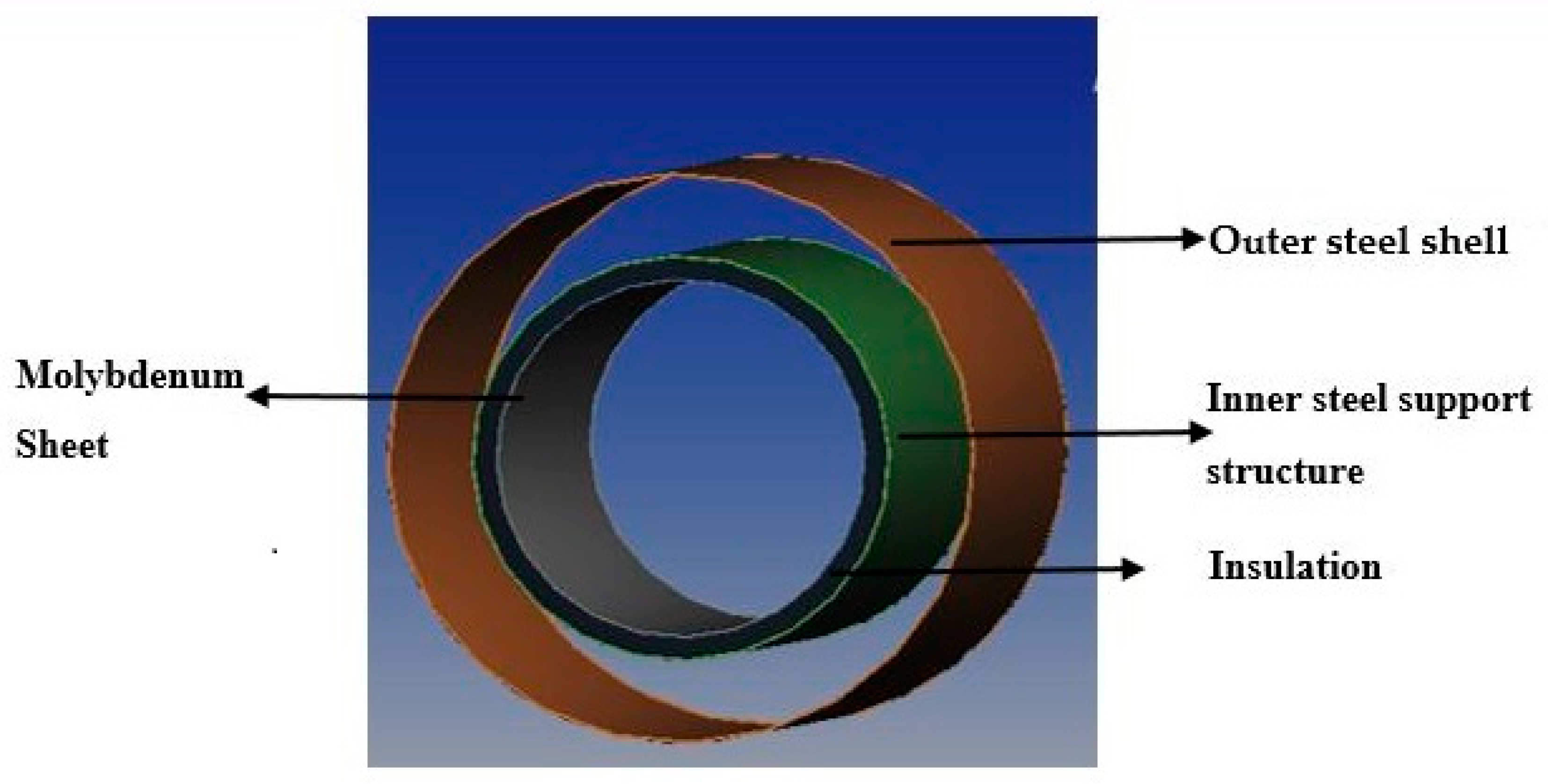

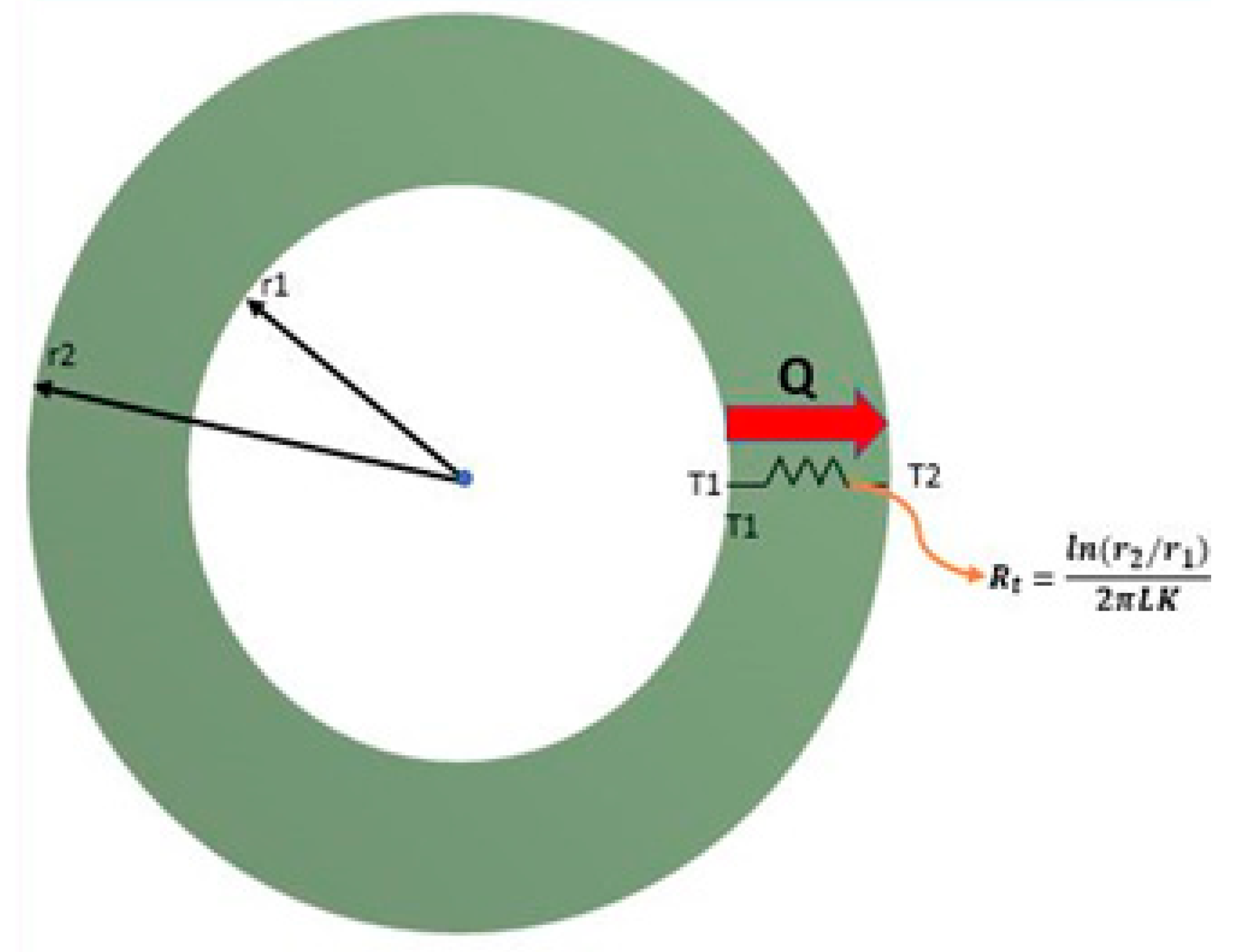
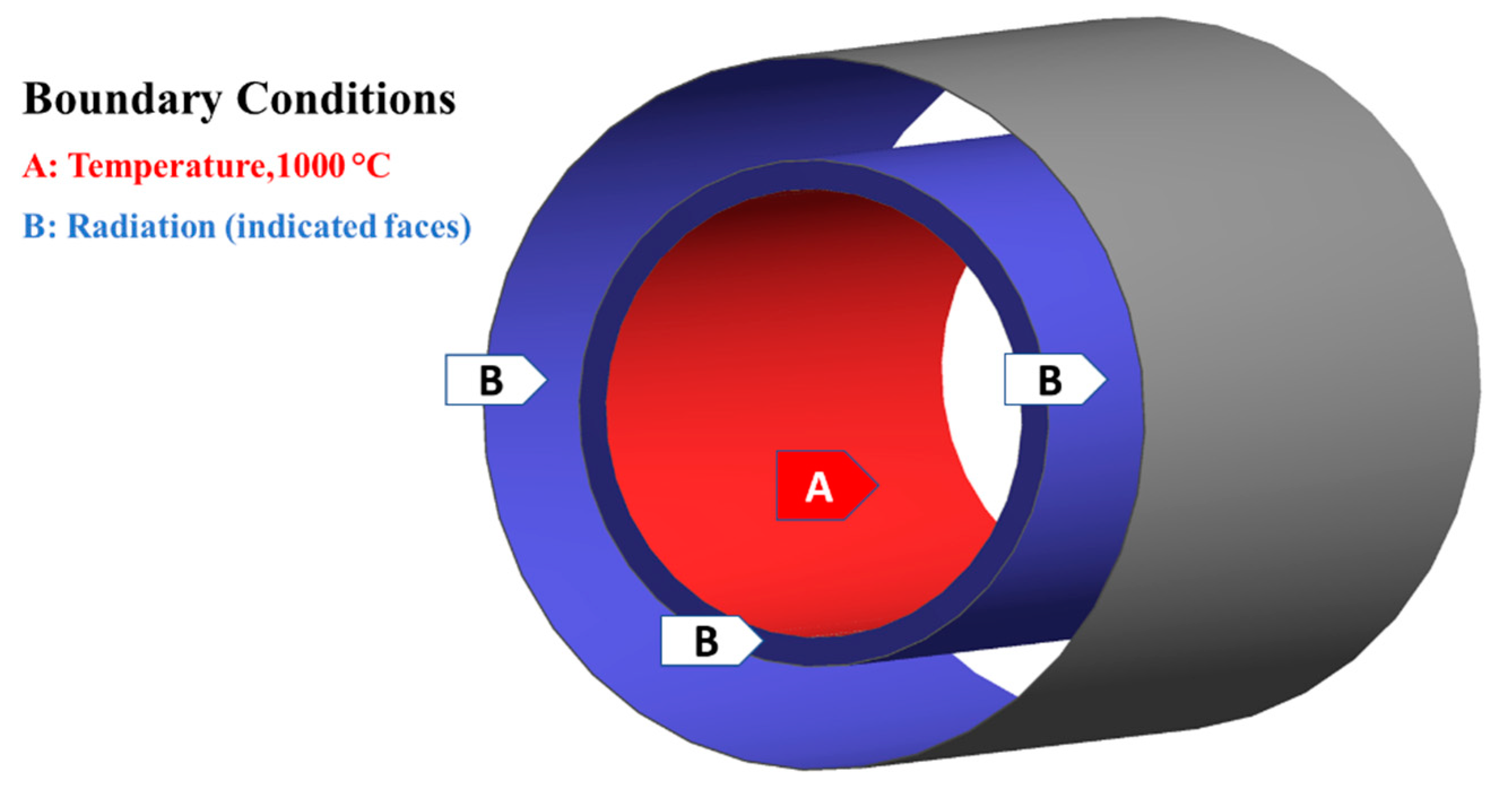
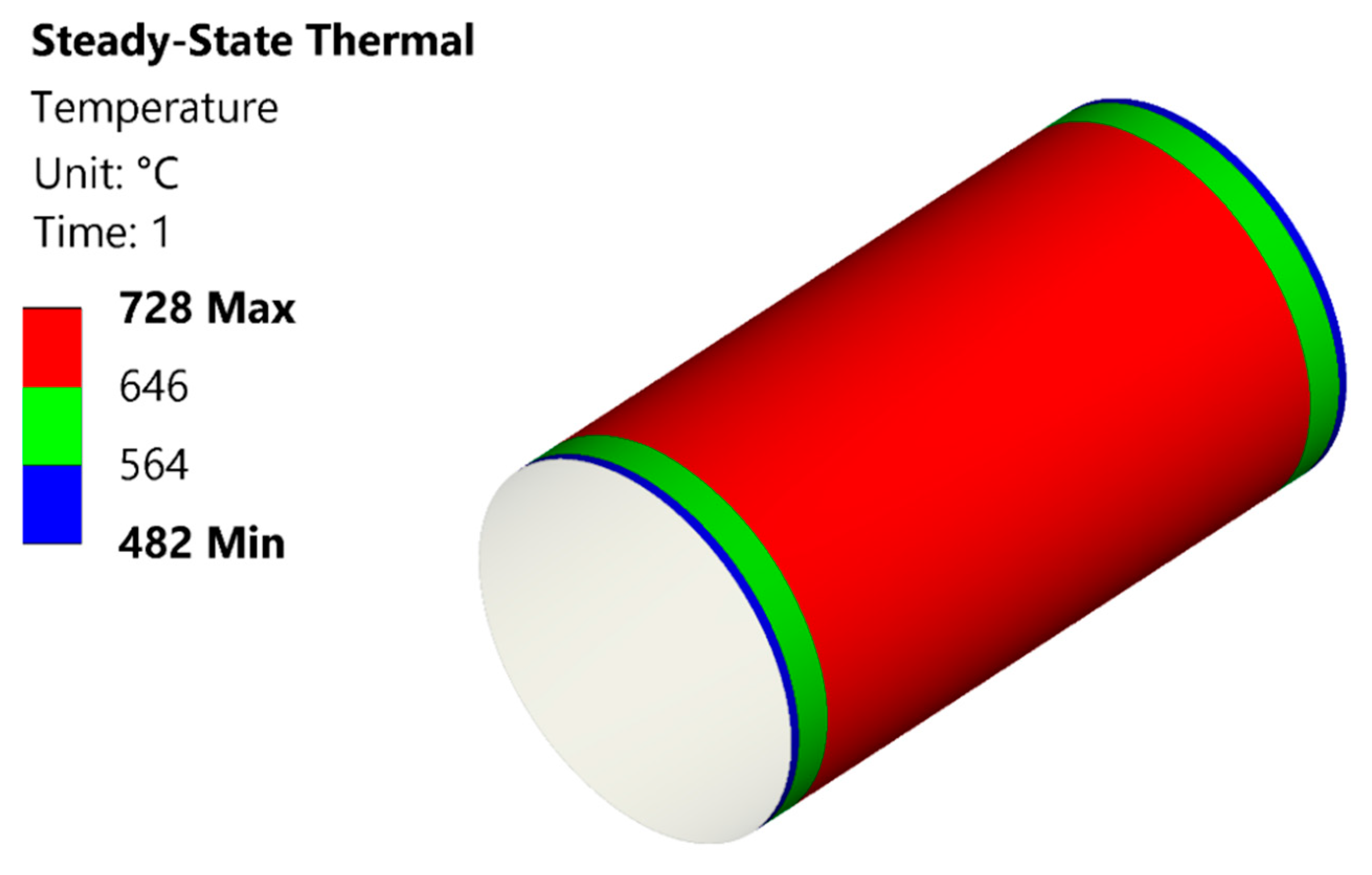


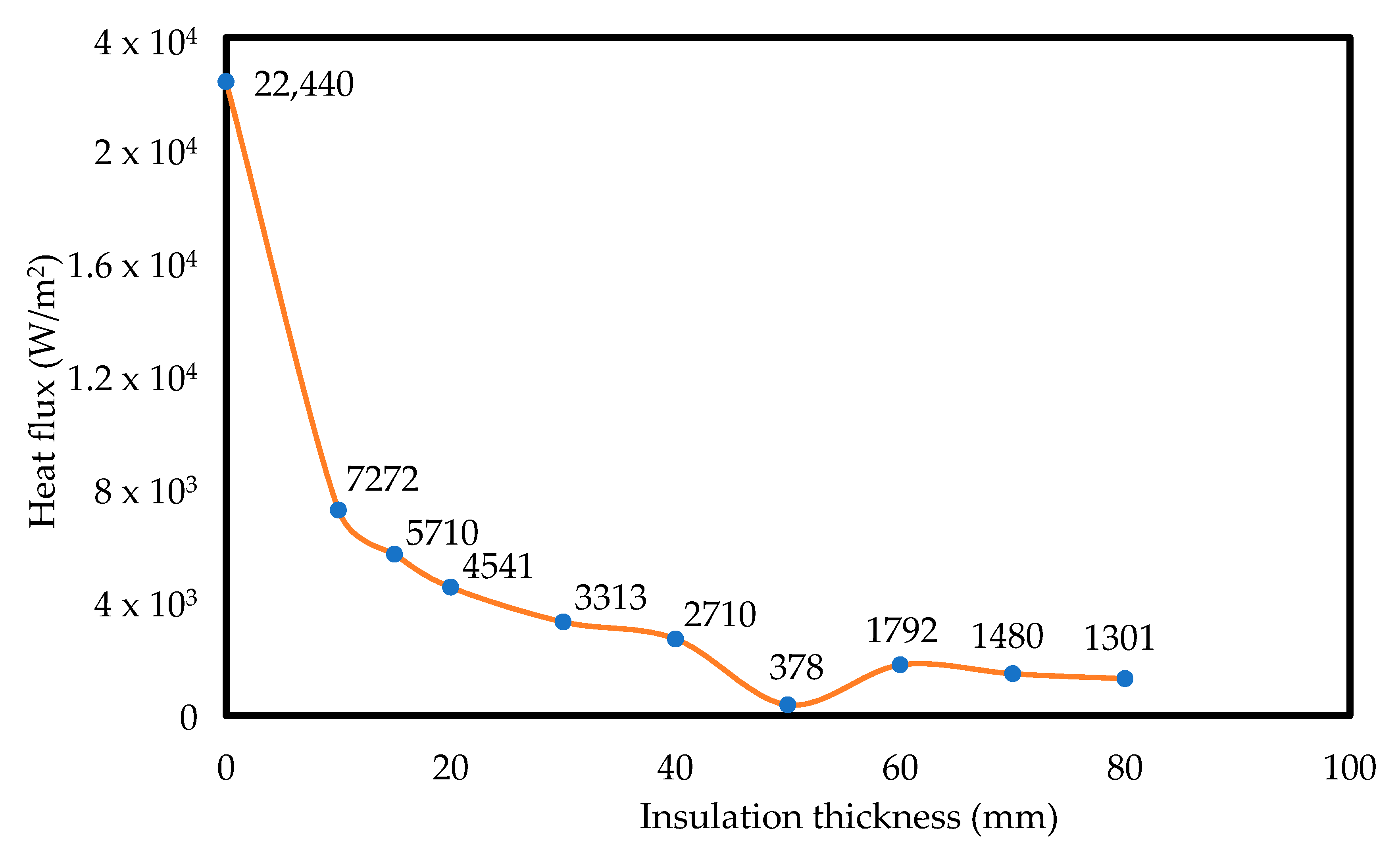

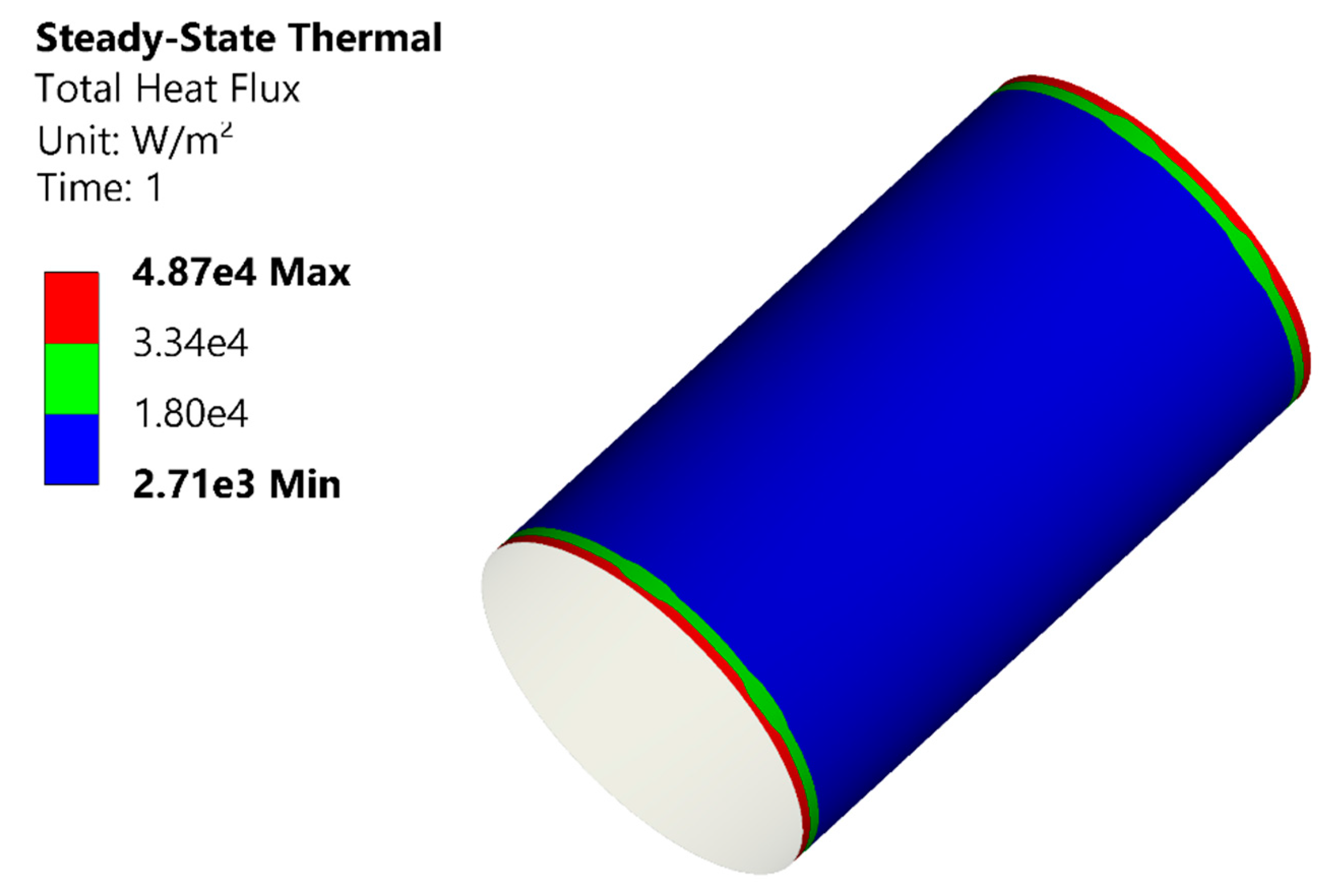
| Insulation: 15 mm Thickness | ||||||
|---|---|---|---|---|---|---|
| Material | K (W/(m.K)) | L (mm) | r1 (mm) | Thickness (mm) | r2 (mm) | Rindividual K/W |
| Molybdenum | 130 | 1240 | 315 | 0.5 | 315.5 | 1.57 × 10−6 |
| Graphite felt | 0.45–0.55 ** | 1240 | 315.5 | 15 | 330.5 | 1.32 × 10−2 |
| Stainless steel | 13.8 | 1240 | 330.5 | 2 | 332.5 | 5.61 × 10−5 |
| Property | Material Description | ||
|---|---|---|---|
| Molybdenum | Graphite Felt | Stainless Steel | |
| Thermal Conductivity (W/(m.K)) | 110–130 | 0.45–0.55 | 13.8 |
| Emissivity | 0.82 | 0.96–0.99 | 0.66 |
| Density (g/cm3) | 10.28 | 1.8 | 8 |
| Sr. No | Insulation Thickness (mm) | Temperature °C | ΔT, °C | Q″, W/m2 |
|---|---|---|---|---|
| 1 | 0 | 993 | 7 | 22,440 |
| 2 | 10 | 657 | 342 | 7272 |
| 3 | 15 | 613 | 387 | 5710 |
| 4 | 20 | 569 | 431 | 4541 |
| 5 | 30 | 521 | 479 | 3313 |
| 6 | 40 | 492 | 508 | 2710 |
| 7 | 50 | 474 | 525 | 378 |
| 8 | 60 | 460 | 540 | 1792 |
| 9 | 70 | 453 | 546 | 1480 |
| 10 | 80 | 450 | 549 | 1301 |
| Furnace Configuration | Temperature °C | Q″ W/m2 | ||
|---|---|---|---|---|
| Experimental | Numerical | Experimental | Numerical | |
| Existing Furnace | 718 | 728 | 8650 | 9120 |
| Modified Furnace | 468 | 492 | 3115 | 2710 |
© 2019 by the authors. Licensee MDPI, Basel, Switzerland. This article is an open access article distributed under the terms and conditions of the Creative Commons Attribution (CC BY) license (http://creativecommons.org/licenses/by/4.0/).
Share and Cite
Badshah, S.; Atif, M.; Ul Haq, I.; Abdullah Malik, S.; Badshah, M.; Jan, S. Thermal Analysis of Vacuum Resistance Furnace. Processes 2019, 7, 907. https://doi.org/10.3390/pr7120907
Badshah S, Atif M, Ul Haq I, Abdullah Malik S, Badshah M, Jan S. Thermal Analysis of Vacuum Resistance Furnace. Processes. 2019; 7(12):907. https://doi.org/10.3390/pr7120907
Chicago/Turabian StyleBadshah, Saeed, Muhammad Atif, Ihsan Ul Haq, Suheel Abdullah Malik, Mujahid Badshah, and Sakhi Jan. 2019. "Thermal Analysis of Vacuum Resistance Furnace" Processes 7, no. 12: 907. https://doi.org/10.3390/pr7120907
APA StyleBadshah, S., Atif, M., Ul Haq, I., Abdullah Malik, S., Badshah, M., & Jan, S. (2019). Thermal Analysis of Vacuum Resistance Furnace. Processes, 7(12), 907. https://doi.org/10.3390/pr7120907






